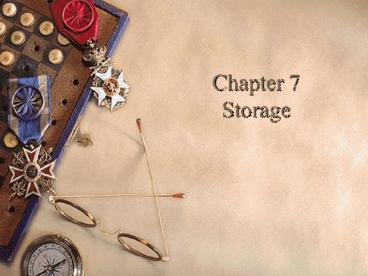Chapter 7 Storage - PowerPoint PPT Presentation
1 / 27
Title:
Chapter 7 Storage
Description:
HARD DISKS. Primary media for storing software programs and files ... Removable Hard Disks. Large storage capacity (60 GB or more) Easily transported ... – PowerPoint PPT presentation
Number of Views:104
Avg rating:3.0/5.0
Title: Chapter 7 Storage
1
Chapter 7Storage
2
Chapter 7 Objectives
Discuss the various types of items that users
store on computer media
Describe the characteristics ofCDs and DVDs
Differentiate between storage devicesand storage
media
Differentiate among CD-ROMs,CD-RWs, DVD-ROMs,
and DVDRWs
Describe the characteristics ofa floppy disk
drive
Identify the uses of tape
Identify the uses of Zip disks
Discuss PC Cards and the various typesof
miniature storage media
Describe the characteristics ofa hard disk
Identify uses of microfilm and microfiche
Identify the advantages of usingan Internet hard
drive
3
MEMORY VERSUS STORAGE
- Memory
- Fast
- Short term
- RAM is Volatile
- Holds the current program and its data
4
MEMORY VERSUS STORAGE
- Storage
- Slower
- Long term
- Nonvolatile
- Stores programs and data for future use
- Can be thought of as both input and output device
- Input read data from storage into memory
- Output transfer data from memory to storage
5
MEMORY VERSUS STORAGE
- Storage Capacity how many bytes (characters) a
storage medium can hold - Kilobyte (KB) 1 thousand (1,000)
- Megabyte (MB) 1 million (1,000,000)
- Gigabyte (GB) 1 billion (1,000,000,000)
- Terabyte (TB) 1 trillion (1,000,000,000,000)
- Petabyte (PB) 1 quadrillion (1,000,000,000,00
0,000) - Exabyte (EB) 1 quintillion (1,000,000,000,000
,000,000)
6
STORAGE
- What is access time?
- Time it take storage device to locate and
retrieve an item.
fastertransferrates
slowertransferrates
7
FLOPPY DISKS
- Characteristics of a Floppy Disk
- Magnetic
- Size
- 3.5-inch, 5.25-inch
- Anatomy
- Shutter
- Shell
- Liner
- Disk
- Hub
- Write-protect notch
8
FLOPPY DISKS
- Characteristics of a Floppy Disk
- Formatting preparing a floppy disk for use
- Track
- Sector
- Cluster
- Capacity sides x tracks x sectors per track x
bytes per sector - File allocation table (FAT)
How the Floppy Drive Works
9
FLOPPY DISKS
- Zip Disks
- 100 MB to 750 MB
- The larger ones areequivalent to about500
diskettes! - Require a zip drive
10
HARD DISKS
- Primary media for storing software programs and
files - Up to 160 GB capacity and more on PC hard disk
- Consists of several platters
11
HARD DISKS
- Characteristics of a Hard Disk
actualdiskcapacity
12
HARD DISKS
- How a Hard Disk Works
- Arms move read/write heads to proper location on
the platters - Read/write head floats above platter
- How it Works
hair
read/write head
dust
smoke
gap
platter
13
HARD DISKS
- How a Hard Disk Works
- Cylinder location of a single track through all
platters - Disk cache improves performance
- Partitions function as separate drives
14
HARD DISKS
- External Hard Disks
- Capacities up to 250 GB or more
- Removable Hard Disks
- Large storage capacity (60 GB or more)
- Easily transported
- Iomegas Peerless disk (up to 40 GB)
- USB Portable Drives
- Capacity up to 1 GB
- Fit on a key chain
15
HARD DISKS
- RAID
- Redundant array of independent disks
- Increased reliability through redundancy
- Expensive
- Many levels of RAID
- Mirroring
- Striping
16
HARD DISKS
- Maintaining Data Stored on a Hard Disk
- Preventative maintenance
- Backup
- Defragmentation
17
HARD DISKS
- Internet Hard Drive (Online Storage)
- Service on the web that provides storage to
computer users - Fee usually involved
- Iomegas iStorage
18
CDs and DVDs
- Used to distribute software packages
- Uses a laser beam to read and write data
- Stores items in spiraling tracks
- Sectors are all the same size
19
CDs and DVDs
- CD-ROM
- Compact disc read-only memory
- Cannot be erased or modified
- Can contain text, graphics, and video as well as
sound - Capacity about 650 MB 450 diskettes to 1GB
- CD-ROM drive speed
How the CD-ROM Works
20
CDs and DVDs
- Writable CDs
- CD-R (compact disc-recordable)
- Multisession
- Can read/write audio CDs and standard CD-ROMs
- CD-ROM drives can usually read CD-R
- CD-RW (compact disc-rewritable)
- Erasable
- Can read any format CD
- Older CD-ROM drives cant read them
- Photo CD
21
CDs and DVDs
- DVD-ROM (Digital versatile disc-ROM or Digital
Video Disc-ROM)
- Can hold much more data than CD-ROMs
- 4.7 GB to 17 GB
- Higher quality than CD-ROMs
- Often used for video
22
CDs and DVDs
- DVD variations
- Digital movies and audio
- DVD-R is single-session recordable
- DVDRW is rewritable
23
MAGNETIC TAPES
- Cost effective way to store large amounts of
infrequently used data - Types
- Reel-to-reel on older systems
- Tape cartridge
- Access technique
- Sequential access (tapes)
- Direct access (floppy disks, hard disks, CDs,
DVDs)
24
PC CARDS
- Thin, credit card-sized device that fits into a
PC Card expansion slot of laptop - Add storage, memory, communications, and sound
capabilities
25
OTHER TYPES OF STORAGE
- Smart Cards
- Similar in size to credit card or ATM card
- Has an embedded microprocessor
- Types
- Intelligent (with a microprocessor)
- Memory card (storage only, as with a digital
camera) - Prepaid smart cards
- Electronic money
26
OTHER TYPES OF STORAGE
- Microfilm and Microfiche
- Stores microscopic images of documents on roll or
sheet film - Often used by libraries and banks due to length
of life
27
Chapter 7 Complete































